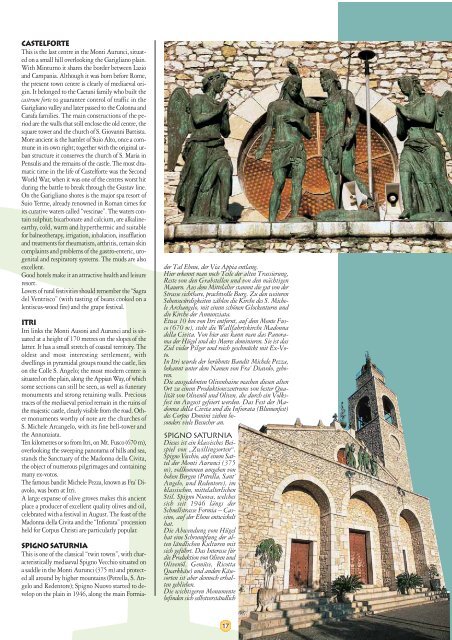Sie wollen auch ein ePaper? Erhöhen Sie die Reichweite Ihrer Titel.
YUMPU macht aus Druck-PDFs automatisch weboptimierte ePaper, die Google liebt.
Castelforte<br />
This is the last centre in the <strong>Monti</strong> Aurunci, situated<br />
on a small hill overlooking the Garigliano plain.<br />
With Minturno it shares the border between Lazio<br />
and Campania. Although it was born before Rome,<br />
the present town centre is clearly of mediaeval origin.<br />
It belonged to the Caetani family who built the<br />
castrum forte to guarantee control of traffic in the<br />
Garigliano valley and later passed to the Colonna and<br />
Carafa families. The main constructions of the period<br />
are the walls that still enclose the old centre, the<br />
square tower and the church of S. Giovanni Battista.<br />
More ancient is the hamlet of Suio Alto, once a commune<br />
in its own right; together with the original urban<br />
structure it conserves the church of S. Maria in<br />
Pensulis and the remains of the castle. The most dramatic<br />
time in the life of Castelforte was the Second<br />
World War, when it was one of the centres worst hit<br />
during the battle to break through the Gustav line.<br />
On the Garigliano shores is the major spa resort of<br />
Suio Terme, already renowned in Roman times for<br />
its curative waters called “vescinae”. The waters contain<br />
sulphur, bicarbonate and calcium, are alkalineearthy,<br />
cold, warm and hyperthermic and suitable<br />
for balneotherapy, irrigation, inhalation, insufflation<br />
and treatments for rheumatism, arthritis, certain skin<br />
complaints and problems of the gastro-enteric, urogenital<br />
and respiratory systems. The muds are also<br />
excellent.<br />
Good hotels make it an attractive health and leisure<br />
resort.<br />
Lovers of rural festivities should remember the “Sagra<br />
del Ventrisco” (with tasting of beans cooked on a<br />
lentiscus-wood fire) and the grape festival.<br />
Itri<br />
Itri links the <strong>Monti</strong> Ausoni and Aurunci and is situated<br />
at a height of 170 metres on the slopes of the<br />
latter. It has a small stretch of coastal territory. The<br />
oldest and most interesting settlement, with<br />
dwellings in pyramidal groups round the castle, lies<br />
on the Colle S. Angelo; the most modern centre is<br />
situated on the plain, along the Appian Way, of which<br />
some sections can still be seen, as well as funerary<br />
monuments and strong retaining walls. Precious<br />
traces of the mediaeval period remain in the ruins of<br />
the majestic castle, clearly visible from the road. Other<br />
monuments worthy of note are the churches of<br />
S. Michele Arcangelo, with its fine bell-tower and<br />
the Annunziata.<br />
Ten kilometres or so from Itri, on Mt. Fusco (670 m),<br />
overlooking the sweeping panorama of hills and sea,<br />
stands the Sanctuary of the Madonna della Civita,<br />
the object of numerous pilgrimages and containing<br />
many ex-votos.<br />
The famous bandit Michele Pezza, known as Fra’ Diavolo,<br />
was born at Itri.<br />
A large expanse of olive groves makes this ancient<br />
place a producer of excellent quality olives and oil,<br />
celebrated with a festival in August. The feast of the<br />
Madonna della Civita and the “Infiorata” procession<br />
held for Corpus Christi are particularly popular.<br />
Spigno Saturnia<br />
This is one of the classical “twin towns”, with characteristically<br />
mediaeval Spigno Vecchio situated on<br />
a saddle in the <strong>Monti</strong> Aurunci (375 m) and protected<br />
all around by higher mountains (Petrella, S. Angelo<br />
and Redentore); Spigno Nuovo started to develop<br />
on the plain in 1946, along the main Formiader<br />
Tal Ebene, der Via Appia entlang.<br />
Hier erkennt man noch Teile der alten Trassierung,<br />
Reste von den Grabstellen und von den mächtigen<br />
Mauern. Aus dem Mittelalter stammt die gut von der<br />
Strasse sichtbare, prachtvolle Burg. Zu den weiteren<br />
Sehenswürdigkeiten zählen die Kirche des S. Michele<br />
Archangelo, mit einem schönen Glockenturm und<br />
die Kirche der Annunziata.<br />
Etwa 10 km von Itri entfernt, auf dem Monte Fusco<br />
(670 m), steht die Wallfahrtskirche Madonna<br />
della Civita. Von hier aus kann man das Panorama<br />
der Hügel und des Meeres dominieren. Sie ist das<br />
Ziel vieler Pilger und reich geschmückt mit Ex-Voto.<br />
In Itri wurde der berühmte Bandit Michele Pezza,<br />
bekannt unter dem Namen von Fra’ Diavolo, geboren.<br />
Die ausgedehnten Olivenhaine machen diesen alten<br />
Ort zu einem Produktionszentrums von bester Qualität<br />
von Olivenöl und Oliven, die durch ein Volksfest<br />
im August gefeiert werden. Das Fest der Madonna<br />
della Civita und die Infiorata (Blumenfest)<br />
des Corpus Domini ziehen besonders<br />
viele Besucher an.<br />
SPIGNO SATURNIA<br />
Dieses ist ein klassisches Beispiel<br />
von „Zwillingsorten“.<br />
Spigno Vecchio, auf einem Sattel<br />
der <strong>Monti</strong> Aurunci (375<br />
m), vollkommen umgeben von<br />
hohen Bergen (Petrella, Sant’<br />
Angelo, und Redentore), im<br />
klassischen, mittelalterlichen<br />
Stil. Spigno Nuova, welches<br />
sich seit 1946 längs der<br />
Schnellstrasse Formia – Cassino,<br />
auf der Ebene entwickelt<br />
hat.<br />
Die Abwendung vom Hügel<br />
hat eine Schrumpfung der alten<br />
ländlichen Kulturen mit<br />
sich geführt. Das Interesse für<br />
die Produktion von Oliven und<br />
Olivenöl, Gemüse, Ricotta<br />
Quarkkäse) und andere Käsesorten<br />
ist aber dennoch erhalten<br />
geblieben.<br />
Die wichtigeren Monumente<br />
befinden sich selbstverständlich<br />
17

















